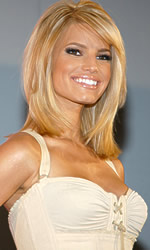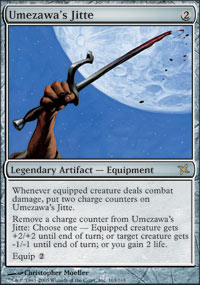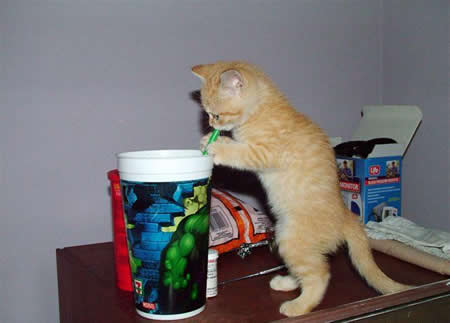
If you want to scare people, it helps to know what they're afraid of. If you know what someone is most afraid of, and they are truly scared enough of it, you can freak them out simply by mentioning it. For example, want to scare a fly? Talk about spiders. Want to scare a bird? Talk about cats. Want to scare a fish? Talk about Jaws. Want to scare James Bond? Talk about monogamy. Want to scare a Magic player? Talk about the upcoming re-release of Homelands.

OK, sometimes newer and
prettier is better.
Way back in the day, Wizards of the Coast managed to produce both their best and worst sets ever. Remarkably they did this within a few months of each other. Alliances is the "original" best set ever. Invasion Block made a play for the crown, as Ravnica block is doing now. But both sets owe so much to Alliances that saying they are better is about like saying Lenny Kravitz is better than Jimi Hendrix, or Oasis is better than the Beatles, or Eminem is better than Elvis Presley. Newer and prettier is most definitely not always better.
The Grandaddy of Sets
Oh, so you don't think Alliances is responsible for Invasion and Ravnica? Really. Compare Kicker and Replicate to Undergrowth, Taste of Paradise, and Primitive Justice. The bounce duals and guildlands? Check out Balduvian Trading Post and Soldevi Excavations. Wizards might say the bounce duals are products of Karoo, but where do you think Karoo's idea came from? Guildmages don't bear any resemblance to Wandering Mage or Pheldagriff do they? Multicolor? Off-color activation costs? Yep, Alliances had those too.

I inspired both Kicker and Replicate.
But enough about the greatness of Alliances, Invasion, and Ravnica. Let's talk about just how truly bad Homelands was for a minute. Homelands was so bad that Wizards had to introduce a rule mandating players had to include at least five cards from every Standard-legal set in thier decks. [If you hear talk of the "Homedicapped" format, this was it. -Ed.] For the most part, this meant people played with a ten-card sideboard and threw the worthless, unplayable Homelands cards in there. Sometimes Ihsan's Shade, Spectral Bears, or Serrated Arrows would see play, but only because they were good against Necropotence decks in the case of the latter two, and immune to the removal trinity in the former. Long term, only Memory Lapse and Merchant Scroll have seen any play, and that is in very limited amounts. I guess you could also make an argument for Primal Order in some Eternal formats, but there it is largely overshadowed by Price of Progress and Back to Basics.
The Bad, The Very Bad
Why was Homelands so bad? Mainly because the effects generated by the cards didn't impact the game very much and cost a lot of mana not to do anything. Does the previous sentence remind anyone of Soulshift?
I judge the value, or "goodness" of a set on the following criteria.
1. Percentage of the set that is playable in a Constructed format (Limited doesn't count because, by definition, in a pinch, EVERYTHING is playable in Limited).
2. Power level of the cards in the set.
3. Depth
4. Creativitability
5. Diversity
6. Overall Theme
Now for an explanation of those criteria. First, the percentage of a given set that is actually playable. Under this criteria Last Gasp and Chalice of the Void would be ranked equally since they are both good answer cards, one in Standard, one in Vintage. A card like Dromad Purebred is an example of something that just will not be played anywhere, ever. Homelands takes the cake on this first criterion since there are literally only six marginally tournament playable cards in the entire set. If we look at Kamigawa Block, we have somewhere around 40ish constructed playable cards.

Yes, I'm broken, but is anything else
from my Block?
This is not an invitation to make lists of cards from Kamigawa you think are playable and try to get a bigger number. A comprehensive, objective set review of Kamigawa Block right now, comparing the cards in it to the cards from every other set in the modern design era (IPA-RAV) would list the vast majority of the cards as "**, Constructed playable in a pinch if you have nothing else." Since the entire Block consisted mainly of "nothing else," you may have a misconception of the cards as being stronger than they actually are.
Before starting the next section I'd like to take a moment to talk about something that people seem to be getting confused about. That is how I'm judging the "pushed" cards. Cards don't make it in here because they have an effect on a format. Cards make it in here because they have a high power level when evaluated by themselves. Yes, Forbidden Orchard has made a big impact in Vintage by enabling Oath decks. Yes, Gifts Ungiven has inspired some new Vintage archetypes. Gifts makes it into the pushed section and Orchard doesn't because Orchard is not an intrinsically strong card, Oath of Druids is an intrinsically strong card that Orchard happens to have a nice interaction with, whereas Gifts is an intrinsically strong card that has been built around and exploited. It's a subtle but important difference when assessing card quality and power.
Over, Under and Around the Cost
To address the second criterion of the sets' power level, we look at the number of cards in the set which have effects that are disproportionate to thier mana costs. In Homelands' case, we start and stop at Memory Lapse, which is more likely correctly costed than overcosted. In Kamigawa we have Umezawa's Jitte, Sakura-Tribe Elder, Meloku, the Clouded Mirror, and Gifts Ungiven. Also note that Jitte, while arguably the most powerful card in the Block, was only played in about half the creature decks in Standard when it was legal thanks to the Mirrodin Swords of Protection. You can make an argument that various Legends or Pithing Needle belong here, but they're really just correctly costed in a set where everything else is exceptionally weak or overcosted. Kamigawa block simply did not have very many aggressively costed, or "pushed" cards. Again, run the numbers and we find that Kamigawa, with six times as many cards has about the same percentage of "pushed" cards as Homelands.
The Deep End of the Pool
Now we come to the issue of depth. I define depth as the number of playable cards there are there to achieve a certain effect. For example, Black removal in Ravnica is extremely deep, including Last Gasp, Disembowel, Putrefy, Mortify, Sieze the Soul, Darkblast, and Ribbons of Night. In Homelands Black removal consists of Torture, Broken Visage, and the sort-of removal, Funeral March. That's ALL the Black removal, not the good stuff. In Kamigawa Block we have Rend Flesh and Rend Spirit, Hero's Demise, Sickening Shoal, and Horobi's Whisper. The Rends and Demise are risky choices to include in a deck given the number of times they will be unable to target whatever it is you need to kill. The only places where Kamigawa Block really achieved any depth was in the number of small, efficient Black and White creatures, graveyard recursion, and the amount of Blue counters and card draw spells/effects. This is why Black Hand, White Weenie, Gifts, and MUC were the main decks of Kami Block Constructed: they were the only strategies that had sufficient depth to play with.
At this point, I imagine several of you are thinking, "But wait, what about Ghost Dad?" I'll answer that by saying simply that Ravnica was designed to work with Kamigawa. Arguing that a set that produces ONE deck in Standard, in the areas it was deepest in, and only with significant support from another block that was designed after the fact to be backwards compatible, makes for a good, powerful block... well, color me unimpressed. You can build good, competitive decks in Standard without Tallowisp. You can't build good decks in Standard without Orzhov cards.
Eureka!
Next up we have creativitability, which is a word I made up to describe how conducive a set is enabling creative deckbuilding. Odyssey through Mirrodin blocks score very low here as you either play one of the block mechanic-based decks or you lose, a lot. Kamigawa Block was very uncreative because a few cards were so much better than the rest that you either played with those cards or faced such a huge drop-off in card quality that you were almost guaranteed to lose. Homelands had such a poor card pool that you literally couldn't build a deck around anything from it. Ravnica is amazingly creative because you can combine any number of color pairings and successfully build a deck using high quality cards.
I've always thought that the greatest indictment of Kamigawa Block is Affinity. In every format it was legal in, Affinity was one of the top-tier decks, but always had some good competition. Darksteel/Skullclamp era? Shared the top tables with Goblins and Elf & Nail (once the deck was discovered). OLS/MD5 era? G/W Slide was highly competitive. Extended pre-banning? Rock, Tooth, Slide, Domain and Goblins were all in the top ranks. MD5 Block? Affinity and Big Red, not just Affinity. Mirrodin + any incarnation of Kamigawa Block? Affinity is the CHAMPION!!! MUST BE BANNED!!! Only Tooth was worth otherwise considering. This led to quite simply the most uncreative format the game had seen since, um, like, ever. You played Affinity, or you played Tooth, or you played a deck that lost to one of them.
Overshadowed? Or Eclipsed?

I enable more than one type of deck
to be played.
Vorthos in the . . . Wait, Where'd he Go?
Finally, we have the overall "theme" of the set. Most sets have a theme which can be used in a majority of the Blocks decks. IPA had multicolor. Most decks of the IPA era were more than one color. OTJ had the whole Graveyard thing going on. In almost any deck featuring OTJ cards, the Graveyard is an important resource. OLS featured Cycling and Tribes. Again, decks using OLS cards utilize and epitomize those mechanics. MD5 was based around artifacts, and it is the rare deck heavily influenced by MD5 cards which doesn't run at least a few artifacts. RG(D), like IPA is a multicolor block and there really aren't any mono-colored decks running around in Standard right now. CBS was built around the idea of two worlds locked in conflict regardless of color. There was a chance to build some great "intra-color" hate cards, have decks of Kamis facing off against decks full of mortals. Except, none of that happened. The mortals didn't get any mechanics aside from Bushido and Ninjitsu. The spirits didn't get enough small, cheap spells and creatures to make good competitive decks. About the closest anything came to being a "spirit-world" deck was Block Gifts with all of its Arcane spells and Spirit creatures. And colorless tokens to reduce art costs. Seriuosly, was the few thousand Wizards saved on art worth not having Promise of Bunrei make White tokens, or Honden of Life's Web not make Green ones? Having a deck full of brave Samurai and mortals, supported by their own mechanics facing off against a Kami deck full of cheap sacrificing creatures, larger Soulshift ones, Arcane spells and Wisdom-enhanced cards would have been very, very cool. However, this didn't happen because the set sucks like Aaron Carter in the Ultimate Showdown.
In short, Kami Block is truly a terrible set because 1)It lacks a sufficient percentage of Constructed playable cards; 2)It lacks "pushed" cards with a high power level; 3)The set is shallow on playable cards, enabling only a very few strategies. 4)The set largely nullifies the advantages normally inherent to a good deckbuilder because the quality cards necessary to exploit deckbuilding skill simply are not there; 5)The set discourages variety through a lack of dual lands and viable strategies; 6)Kamigawa's "theme" of a spirit/mortal war was a neat story concept, but didn't play out well at all.
EDIT: I Forgot the Fun!
This is the first time I've ever included an "EDIT" in an article. Normally the procedure in the case of an error noticed during article development is to simply fix the error in the body of the article. However, in this case, the error is conceptual and central to the article's structure and layout. Although we frequently refer to Magic by a variety of shorthand names, such as MTG, Magic, the cardboard crack, etc., it also has a long name, mainly "Magic: the Gathering, Collectible Card Game". I'd like to emphasize the last word in that sentence for a second, Game. Yep, this is a game, not a mathematical equation. There is no overriding principle as important to determining the success of a given set except for one simple question: Is it fun? The most damning thing I can say about Kamigawa Block is that no, it is most resoundingly not fun.
From the accounts of everyone I've talked to, Kamigawa Draft was an extremely fun and vibrant format. Kamigawa Sealed, not so much. Kamigawa Block Constructed consisted of two main parts: Part 1) Who draws the most Umezawa's Jittes first? Part 2) Who wins the first game in the Gifts match because there won't be time for a second game? Yep, that's right, the Block format was in part defined by the amount of time it took the format's best deck to win. Standard? Standard was so bad that Wizards took the unprecedented step of banning an entire deck (well, actually several decks, and significantly hurting several others) not because the deck was too dominant (you can read Forsythe's explanation of the banning here) but because the format was no fun. In Extended Kamigawa has introduced some nice support cards to a variety of decks but hasn't exactly done a whole lot else. In Vintage and Legacy, a few cards, such as Extraction and Gifts have had an impact, but not much else has. To be fair though, three to four cards is a pretty good showing for a new set in those formats.

Unlike Kamigawa, I'm fun
I could go on, but I'll sum up Kamigawa's "unfunness" with a simple comparison. The best, most fun, most popular sets in Magic all have a common theme: they enable, or are friendly towards, multi-color play. It might be easy to get confused and think Kamigawa Block and Rav block are on equal footing in Standard judging by the number of Kami Block cards being played. Take another look at the decks and see how many colors those decks are packing. Kami Block featured G/x decks and mono-colored decks. Ravnica is all about playing with more than one color. How many mono-colored decks are in Standard right now? Why is it like this? 1) Power. 2) Fun. Playing with multiple colors is fun. Winning is fun. Being able to utilize your creativity to create something unique and powerful is fun. Playing big swingy creatures and spells is fun. Kamigawa only contributed to one of those factors. Success 25% of the time won't even keep you in the Big Leagues in baseball as a hitter. Success 25% of the time isn't something you should be aiming for or proud of. Neither should Wizards.
Comments